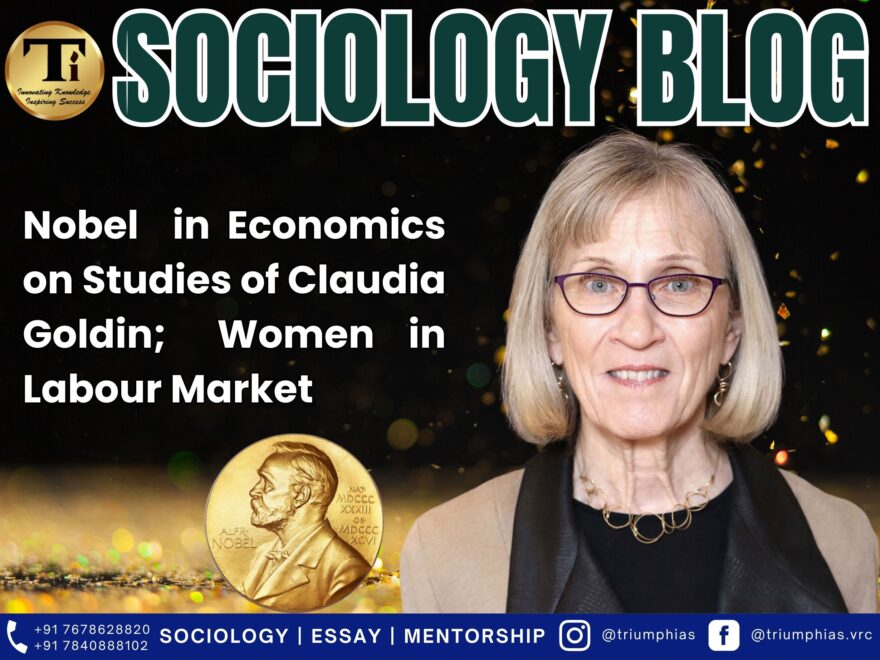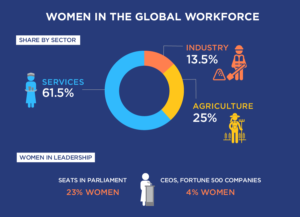Exploring Gender Segregation and Women’s Labor Market Outcomes: Insights from Nobel Prize Winner Claudia Goldin’s Research.
Relevant for Sociology Optional for Civil Services Examination.
Paper 1: Unit-6 Works and Economic Life.
Paper 2: Unit-12 Systems of Kinship; Sexual Division of Labour.
Nobel Prize in Economics for 2023 was awarded Monday (October 9) to Claudia Goldin, a Harvard University professor, for “having advanced our understanding of women’s labour market outcomes”.
What Does studies Claudia Goldin highlights about the women participation in workforce:
Goldin’s research has provided valuable insights into women’s participation in the labor market spanning two centuries and the persistent gender pay gap in high-income countries, despite women’s higher levels of education.
Historical Shifts in Women’s Economic Activity:
- Goldin’s work reveals that prior to industrialization, women were more likely to engage in economic activities related to agriculture and cottage industries.
- However, with the rise of industrialization, work became concentrated in factories, making it challenging for women to leave their homes for employment.
Reversal in the Early 20th Century:
- In the early 20th century, a shift occurred with the growth of the services sector, enabling more women to access employment opportunities.
- The growth of the services sector presented new avenues for women’s participation in the labor market.
Influence of Marriage and Contraception:
- Goldin’s research emphasizes the role of marriage and contraception in shaping women’s access to higher education and employment.
- Historical factors like “marriage bars” limited married women’s employment opportunities, particularly in professions like teaching and office work.
- The contraceptive pill further empowered women to control their reproductive choices and participate in the labor force.
Expectations and Career Choices:
- Goldin highlights that women’s expectations for their careers played a pivotal role in labor market outcomes.
- These expectations were often shaped by the experiences of their mothers, resulting in career decisions that did not anticipate long, uninterrupted, and fruitful careers.
- Women’s career choices were influenced by societal norms and historical factors.
Impact on Gender Pay Gap:
- Despite increasing demand for labor over time, Goldin’s work indicates that the gender pay gap persisted.
- Factors such as marriage bars, historical expectations, and societal norms contributed to the slow reduction of the gap between men’s and women’s rates of employment.
Impact of Childbirth on Pay Gap:
- Goldin, along with co-authors Marianne Bertrand and Lawrence Katz, conducted research in 2010 highlighting the role of childbirth in the gender pay gap.
- They demonstrated that initial earnings differences between men and women were small. However, when the first child arrives, a significant shift occurs, with women experiencing an immediate decline in earnings.
- Women’s earnings do not increase at the same rate as men’s, even if they have the same level of education and work in the same profession.
Parenting Responsibilities:
- The gender pay gap is exacerbated by the unequal distribution of parenting responsibilities, with women often shouldering more caregiving duties.
- This unequal burden of childcare can result in women being penalized in terms of career progression and pay.
Overall, Goldin’s research highlights how historical shifts, societal expectations, and legal barriers have influenced women’s participation in the labor market and the persistence of the gender pay gap. It underscores the importance of understanding these factors in addressing gender disparities in employment and pay.
Sociological Analysis : “Women and Work”
Labour force participation is often seen as the prime indicator (and cause) of changes in women’s status as employment determines their access to resources and their ability to make independent decisions. Work plays an essential part in determining women’s and men’s relative wealth, power and prestige, and health.
On the basis of their work status, women labour can be grouped under the following three categories: —
- Self-employed both within and outside home.
- Wage Workers outside home. agricultural workers, construction workers, factory workers, contract workers etc. and inside home (home based workers engaged in work on out- put basis).
- Unpaid Family Labour on their own farm or family occupations like weaving, pottery, handicrafts etc.
Main characteristics of female labour working in various sectors of economy as follows:
|
Factors leading to gender based discrimination at work.
- Gendered stereotype: The perception of ‘male as the bread winner’ of the family conceals the fact that in low-income households woman’s earning is crucial for the sustenance of the family. This perception adversely affects investment in women’s education and training. Employers also visualize women workers as ‘supplementary earners.
- Lack of ownership: Lack of assets (land, house) in their own name in order to have access to credit and self-employment opportunities has been the important hurdle in the upward mobility of women workers.
- Gendered segregation of work: Gender segregation in the workforce is the phenomenon where women and men find themselves in distinct occupational categories, effectively creating separate labour markets for each gender.
- This segregation has its roots in the concept of gender marking, a process through which the qualifications and attributes associated with specific occupations become closely linked with a particular gender. This process essentially prescribes which gender is deemed suitable for a given job.
- Gender marking becomes evident as certain occupations come to be seen as predominantly for either females or males. In essence, gender segregation can be understood as an outcome resulting from the gender marking of qualifications, characteristics, job roles, and occupational functions.
- Gender segregation is highly complex and is reflected at all levels— horizontal, vertical and internal.
-
- Internal Gender Segregation: Within the same occupation, women and men perform different job functions, even if they work for the same employer, perpetuating gender divisions.
- Horizontal Segregation: Women tend to work in specific industries like services and caregiving, while men dominate sectors like heavy industry, reflecting societal gender roles.
- Vertical Segregation: In mixed occupations, men often hold higher managerial positions, while women occupy lower-paying and less secure roles, creating hierarchical gender disparities.
- Gender pay gap: Gender pay disparities signal workplace inequality. While equal pay laws exist in many countries, occupational gender segregation enables unequal pay for “men’s” and “women’s” jobs. Women, even in mixed roles, often hold lower-responsibility, poorly compensated positions. They continue to earn less than men, facing limited job benefits, particularly in female-dominated fields with lower wages. This highlights on-going workplace imbalances.
- Gender Composition Shifts and Wage Impact: It is only a matter of observing what happens to a particular occupation that faces a change in its gender composition to study the impact of gender segregation on wages. For example, clerical work was once a practically all male labour force that paid reasonably well as it was considered a highly skilled occupation. Today the gender distribution has changed in many countries and, most clerical workers are female. As a result, clerical work was re-evaluated as less demanding of skill and less valuable to an organization; thus, workers’ wages fell.
- Women as scapegoat: Division of labour between women and men and technological changes in the production system also work against women. They are the first to lose their jobs and the last to be hired. Higher illiteracy and low skill development among women also result in low wages and insecure or casual employment.
- Invisibility of work: Much of women’s work remains unrecognised, uncounted and unpaid, thus invisible.. This hidden work encompasses various activities such as household chores, agricultural work, food production, and the sale of homemade goods. The neglect of this entire realm of unpaid work can be attributed to two primary reasons.
- Firstly, until relatively recently, much of this work was not officially recognized as “work.”
- Secondly, it poses a considerable challenge when it comes to measuring both its time commitment and its economic value. Since women shoulder a substantial portion of this unpaid labour, it has resulted in a profound underestimation of the contributions women make to society and the economy.
- Double Shift or Double Burden: The entry of women into the labour market has not meant any lessening of Gender and Work domestic chores. Most women are still solely or predominantly in charge of housework and child car To fulfil all their responsibilities at the workplace and home, women end up working longer hours. This phenomenon is called ‘double shift or double burden’.
- Dual Roles: Home-Work Balance: It is always a crucial balancing act for women where they cannot be abandoned their domestic responsibilities. This leads them to turn their homes into a workplace or their workplace into a home: small children may spend the whole day at a construction site where their mother is working.
- Navigating Gender Stereotypes in Management: Men sometimes resent assertive, unemotional women and perceive them to be acting like men. Yet, men also judge women who are passive and emotional as unsuitable for management. Women often have to walk a fine line and work towards being perceived as demanding and yet ‘feminine’ to be accepted as a ‘good manager’.
- Glass-Ceiling: There is persistent discrimination against women in promotion which keeps women in low wage positions with little opportunities for upward mobility. Women thus face a double obstacle in attempting to achieve workplace equality. The first is that of centuries-old gender ideologies that bar them from entering well-paying occupations to be pushed into less-paying sectors of the economy. The second obstacle arises ― ‘when they enter those well-paying fields, they are prevented from moving up. This is what is known as the glass-ceiling.
Way forward.
Recognizing Women’s Economic and Social Contributions:
- Women’s roles encompass both productive and reproductive work, often blurring these categories.
- Reproductive work, including childcare and caregiving, indirectly supports the workforce and saves societal and employer expenses.
Challenging Institutionalized Gender Inequality:
- Failing to acknowledge women’s multifaceted contributions perpetuates gender inequality.
- A wider recognition of the significance of women’s work is emerging, emphasizing the need for rigorous gender analysis.
Addressing Data and Occupational Biases:
- The absence of sex-disaggregated employment statistics and biased occupational categories is gaining attention.
- Expanding the definition of economic activity to account for cultural, regional, and seasonal variations is being considered.
Moving Forward Towards Gender Equality:
- Recognizing and valuing women’s economic and social contributions is essential.
- Policymakers and planners are increasingly aware of these issues and are taking steps to address them.
Frequently Asked Questions:
Question 1: Who was awarded the Nobel Prize in Economics in 2023 and for what contribution?
Answer: Claudia Goldin was awarded for advancing the understanding of women’s labour market outcomes.
Question 2: What significant role did marriage and contraception play in women’s access to employment, according to Claudia Goldin’s research?
Answer: They shaped women’s access to higher education and employment by influencing reproductive choices and imposing historical “marriage bars” limiting employment opportunities.
Question 3: Describe the concept of “gender marking” and how it influences gender segregation in the workforce.
Answer: Gender marking links qualifications and attributes of specific occupations with a particular gender, prescribing which gender is deemed suitable for a job, thereby influencing gender segregation in the workforce.
Question 4: How does the phenomenon of “double shift” or “double burden” pertain to women in the workforce?
Answer: It refers to women’s simultaneous management of responsibilities in the paid workforce and unpaid domestic work, leading them to effectively work longer hours.
Question 5: Explain briefly the term “glass-ceiling” in the context of women’s career progression.
Answer: The “glass-ceiling” refers to an invisible barrier that prevents women from advancing into higher-ranking positions within their profession, despite having qualifications and expertise.
Question 6: What is the significance of understanding “internal gender segregation” in a workplace?
Answer: Internal gender segregation implies that within the same occupation, women and men often perform different tasks or roles, perpetuating gender divisions even within similar job titles.
Question 7: How does gender pay gap and occupational gender segregation enable unequal pay in the workplace?
Answer: Occupational gender segregation results in “men’s” and “women’s” jobs, often assigning lower wages to female-dominated roles and sustaining pay disparities even when equal pay laws exist.
Question 8: What are the primary categories under which women labour is grouped based on their work status?
Answer: Women labour is grouped into: Self-employed (both within and outside home), Wage Workers (inside and outside home), and Unpaid Family Labour.
Question 9: How do “horizontal” and “vertical” segregations manifest in the workforce?
Answer: Horizontal segregation involves women and men working in gender-specific industries, while vertical segregation sees men often holding higher managerial positions within mixed occupations, creating hierarchical gender disparities.
Question 10: Why is much of women’s work, especially in the domestic realm, often considered “invisible”?
Answer: Women’s domestic work is deemed “invisible” as it remains unrecognised, uncounted, and unpaid, often due to its non-inclusion in formal economic analyses and the challenge of quantifying its economic value.
Reference: Static Portion
Related Blogs …
 |
 |

To master these intricacies and fare well in the Sociology Optional Syllabus, aspiring sociologists might benefit from guidance by the Best Sociology Optional Teacher and participation in the Best Sociology Optional Coaching. These avenues provide comprehensive assistance, ensuring a solid understanding of sociology’s diverse methodologies and techniques.
META TAGS:
Nobel Prize, Nobel Prize Economic, Nobel Prize in Economics, Nobel Prize 2023, Nobel prize winners, nobel prize medal, Claudia Goldin, Economics, women’s labor market, gender segregation, gender pay gap, women’s economic activity, historical shifts, societal expectations, legal barriers, unpaid women’s work, sociological analysis, self-employed women, wage workers, unpaid family labor, gender stereotypes, gender-based discrimination, gendered segregation, gender composition, invisible work, double shift, dual roles, glass-ceiling, gender equality, economic and social contributions, institutionalized gender inequality, data biases, occupational biases
Why Vikash Ranjan’s Classes for Sociology?
Proper guidance and assistance are required to learn the skill of interlinking current happenings with the conventional topics. VIKASH RANJAN SIR at TRIUMPH IAS guides students according to the Recent Trends of UPSC, making him the Best Sociology Teacher for Sociology Optional UPSC.
At Triumph IAS, the Best Sociology Optional Coaching platform, we not only provide the best study material and applied classes for Sociology for IAS but also conduct regular assignments and class tests to assess candidates’ writing skills and understanding of the subject.
Choose The Best Sociology Optional Teacher for IAS Preparation?
At the beginning of the journey for Civil Services Examination preparation, many students face a pivotal decision – selecting their optional subject. Questions such as “which optional subject is the best?” and “which optional subject is the most scoring?” frequently come to mind. Choosing the right optional subject, like choosing the best sociology optional teacher, is a subjective yet vital step that requires a thoughtful decision based on facts. A misstep in this crucial decision can indeed prove disastrous.
Ever since the exam pattern was revamped in 2013, the UPSC has eliminated the need for a second optional subject. Now, candidates have to choose only one optional subject for the UPSC Mains, which has two papers of 250 marks each. One of the compelling choices for many has been the sociology optional. However, it’s strongly advised to decide on your optional subject for mains well ahead of time to get sufficient time to complete the syllabus. After all, most students score similarly in General Studies Papers; it’s the score in the optional subject & essay that contributes significantly to the final selection.
“A sound strategy does not rely solely on the popular
Opinion of toppers or famous YouTubers cum teachers.”
It requires understanding one’s ability, interest, and the relevance of the subject, not just for the exam but also for life in general. Hence, when selecting the best sociology teacher, one must consider the usefulness of sociology optional coaching in General Studies, Essay, and Personality Test.
The choice of the optional subject should be based on objective criteria, such as the nature, scope, and size of the syllabus, uniformity and stability in the question pattern, relevance of the syllabic content in daily life in society, and the availability of study material and guidance. For example, choosing the best sociology optional coaching can ensure access to top-quality study materials and experienced teachers. Always remember, the approach of the UPSC optional subject differs from your academic studies of subjects. Therefore, before settling for sociology optional, you need to analyze the syllabus, previous years’ pattern, subject requirements (be it ideal, visionary, numerical, conceptual theoretical), and your comfort level with the subject.
This decision marks a critical point in your UPSC – CSE journey, potentially determining your success in a career in IAS/Civil Services. Therefore, it’s crucial to choose wisely, whether it’s the optional subject or the best sociology optional teacher. Always base your decision on accurate facts, and never let your emotional biases guide your choices. After all, the search for the best sociology optional coaching is about finding the perfect fit for your unique academic needs and aspirations.
Follow us :
🔎 https://www.instagram.com/triumphias
🔎https://www.youtube.com/c/TriumphIAS
🔎https://t.me/VikashRanjanSociology
Find More Blogs
| Compare and contrast Karl Marx’s and Max weber’s | Karl Marx- Historical Materialism |
| Position of Women In the Modern Indian Society | Sociology: Social system and pattern variables |






One comment